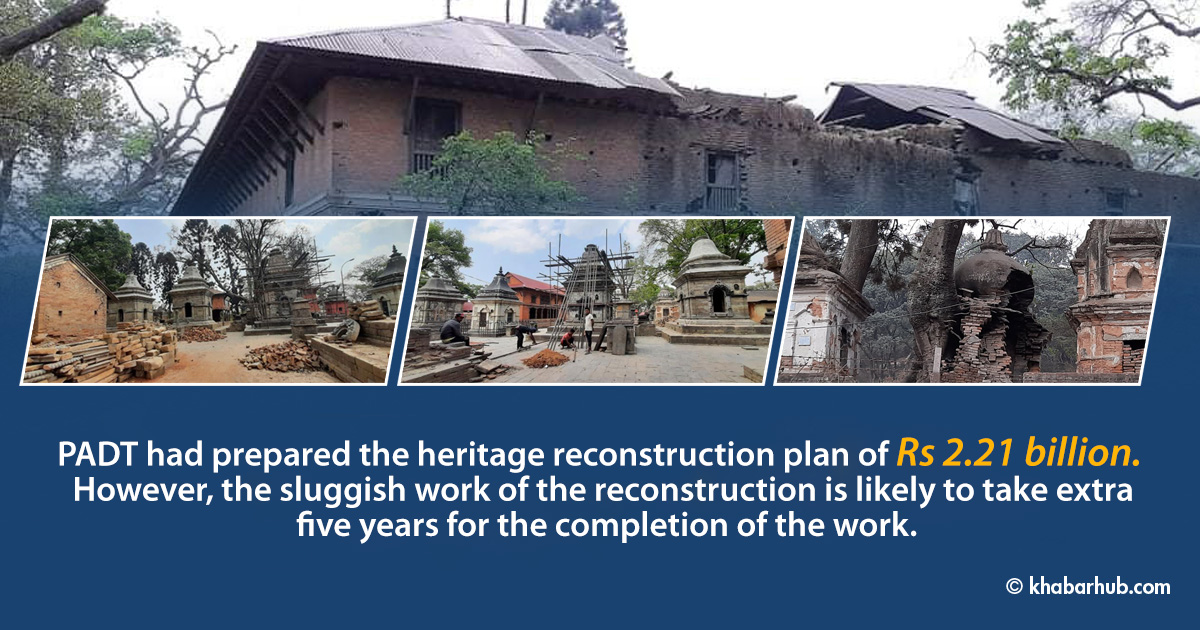0%

KATHMANDU: The aftermath of the 2015 earthquake is still visible in the Pashupatinath, the World Cultural Heritage Site.
The four walls of many temples and sattals of the area are either cracked or crumbled. Entry to these sites is restricted.
Such a scene is of the Bishwarupa Temple at Mrigasthali of the Pashupatinath area in Kathmandu.
The Bishwarupa Temple, built by then Prime Minister Jung Bahadur Rana in the 19th century, was damaged by the massive earthquake of 2015.
Sadly, even after six years of the quake, reconstruction of the temple has not begun yet. The demolished structure has ruined the beauty of the temple.
The Pashupati Area Development Trust (PADT) claims it is starting the reconstruction of Vishwarupa Temple in the coming fiscal year. The PADT has called for tenders for the reconstruction of Vishwarupa Temple and the Sattal next to it.
When inquired about the reconstruction of these cultural sites, Ghanshyam Khatiwada, the executive director of the Trust replied that the reconstruction process has already started; however, some legal complications have deterred the construction.
“Tenders were called for the reconstruction of Vishwarupa Temple and Sattal,” Khatiwada told Khabarhub, “However, as the issue has reached the Supreme Court, we cannot how long the legal issue deters the task.”
According to him, the reconstruction will be completed within five years of the commencement of the work. Khatiwada said that the reconstruction of Bajra Ghar, which was damaged by the earthquake, will be completed in five years.
Why is the reconstruction work so sluggish?
Heritage sites have been crumbling within the Pashupatinath area for six years. Although the progress of reconstruction is noticeable in private housing, educational institutions and health institutions, the pace of cultural heritage is slow.
The National Reconstruction Authority, established for the post-earthquake reconstruction, is expected to complete its work in five years. The government extended the term of NEA by one year. The extended term expires in the last week of December.
Khatiwada says that setting a deadline for the completion of the reconstruction of the heritage of historical and archeological importance as there are various factors likely to influence the reconstruction activities.
“We have to use old bricks, wood and other materials and try to restore the look and glory of such sites,” Khatiwada said, adding, “It takes time to find the goods as per our needs.”
According to him, the Trust officials, engineers and others should be present at the same time to match the amount of lime, silt and clay.
“We have to pay attention to the proportion of dust in old and new bricks,” Director Khatiwada said, “Such work will delay the reconstruction of the heritage.”
He estimates that the completion of the reconstruction at the Pashupatinath area might take the next five years.
Out of 105, only 50 reconstructed in six years
The quake damaged 105 structures, including temples and pavilions in the Pashupatinath area. Of them, only 13 temples and 37 sattals have been reconstructed so far. The remaining 55 are still in a damaged condition.
The PADT had estimated the reconstruction cost for all the structures to be Rs 2.21 billion. Out of it, as of mid-November of the current Fiscal Year, Rs. 518.7 million has been spent.
Under the National Reconstruction Authority, 33 structures of the Area have been reconstructed for Rs 357.4 million and two heritage structures have been reconstructed for Rs. 107 million under the National Pride Project of the Government of Nepal.
Similarly, four heritage structures have been reconstructed for Rs. 3.5 million from internal sources of PADT whereas the other four structures have been reconstructed at Rs. 57.1 million received from the individual and institutional donors.